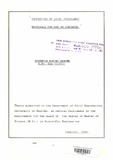| dc.contributor.author | Wahome, Ephantus R | |
| dc.date.accessioned | 2013-05-04T09:40:39Z | |
| dc.date.available | 2013-05-04T09:40:39Z | |
| dc.date.issued | 1990 | |
| dc.identifier.citation | Thesis submitted to the Department of Civil Engineering University of Nairobi. in partial fulfilment of the requirement for the award of the degree of Master of Science (M.Sc.) in Structural Engineering. | en |
| dc.identifier.uri | http://erepository.uonbi.ac.ke:8080/xmlui/handle/123456789/18969 | |
| dc.description.abstract | Pozzolanas are siliceous or siliceous and aluminous materials which will react with calcium hydroxide in the presence of moisture and at ordinary temperatures to produce cementitious products. Pozzolanas are used with either lime or -, cement. In the old days it was cOIIIDonlyused with lime. Today the pozzolanas are mainly used with cement. and they are important cement additives. Pozzolanas have been used for a long time in the construction industry. Many Greek and Roman structures were constructed using pozzolanic binders. Pozzolana blended with lime was found to give a strong and durable binding material. The use of pozzolanas has persisted to this day. This being mainly due to the beneficial properties they give to concrete. Use of pozzolanas may also give an economical concrete mix. In the early days. natural pozzolanas mainly of volcanic origin were used. Today. Artificial pozzolanas such as fly ash are used a lot mainly in the developed countries. The developing countries such as Kenya still use natural pozzolanas. Presently in Kenya the cement manufacturers. the Kenya Portland Cement Factory at Athi River and the Bamburi Portland Cement Factory in Mombasa normally add about 10 percent of pozzolana to cement. However the maximum amount allowable is 15 percent as specified by KS02-21:i976. A Pinkish tuff quarried at Lukenya in the Athi basin is used. Kenya is endowed with different types of naturally available materials such as pumice. phonolite. Basalt. Diatomite. etc. that - ix may have pozzolanic properties, and which are lying unexploited. It is with this in mind that a number of these materials were selected and tests done on them to ascertain their pozzolanic properties. Tests were carried out using standard methods as , the relevant standard specification. The materials phonolite from Embakasi, Gilgil. Yellow tuff from Njiru, Nairobi and Athi tuff from Athi River. The five materials tested were found to be suitable as pozzolanas to varying degrees of cement replacement. Yellow tuff. Athi tuff. Pumice and Phonolite were found to give fairly good results up to ~O percent cement replacement. Diatomite on the other hand was found to give good results up to 15 percent cement replacement. Beyond this level of cement replacement diatomite was found to adversely affect important properties of concrete such as strength. Workability and setting times. | en |
| dc.language.iso | en | en |
| dc.title | Properties of local pozzolanic materials for use in concrete | en |
| dc.type | Thesis | en |
| local.publisher | Department of Structural Engineering | en |

